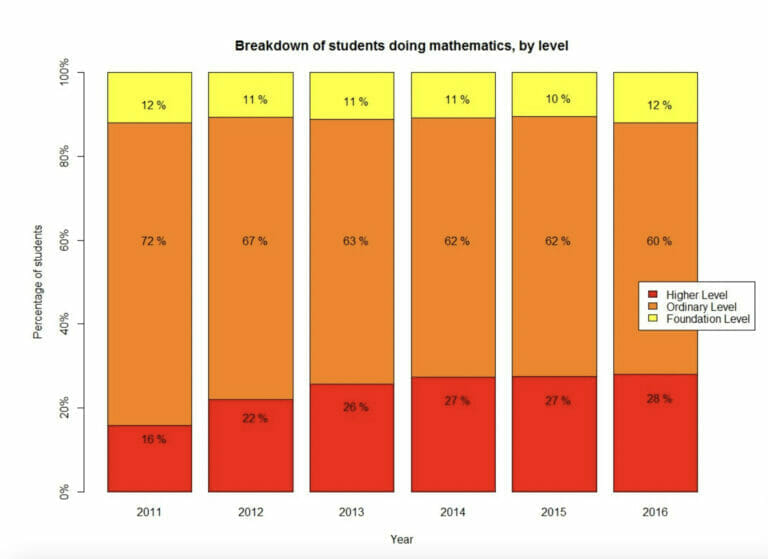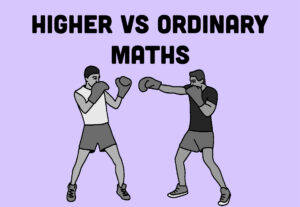WhatsApp:
+353 87 202 0389
I hear it week in, week out. Students are just not sure if they are able for Higher level Maths. And as a parent, how are you meant to help? How can you advise them?
In this blog, I’ll guide you through that decision.
In 2012, a bonus system was introduced. An additional 25 points are now awarded to those who pass HL (Higher Level) Maths with an H6 and above. It’s no surprise that this bonus entices more students to take HL Maths opposed to OL (Ordinary Level) Maths. But, is Higher Level Maths really worth it in the end? Will the extra 25 points give you an advantage when it comes to University acceptances? Or, will the pressure of HL Maths actually cause you to lose points in your other Leaving Cert subjects? It’s a tough call to make for many students, but a very important one nonetheless.
The Effect Of The 25 Point Bonus
The new bonus system was introduced in 2012. Since then, there has been a growing number of students opting to take HL Maths. In 2022, 36% of Leaving Cert students took HL Maths, compared to 18% in 2012. That’s double the amount of students taking HL Maths now compared to in 2012.
You can see in this diagram the increase in students taking HL Maths from 2011 to 2016:

But has this increase in students negatively affected the amount of people passing? No. The grading system for the Leaving Cert is based on a bell curve. Even if the number of students taking the exam increases, the percentage who pass remains relatively the same. In fact, only 0.5% of people failed Higher Level Maths in 2023. Odds are, if you are unsure about taking HL Maths, there is a 99.5% chance you will pass the exam.
Along with the extremely low percentage of people that fail, the most common results are H3-H5. So, most likely if you take Higher Level Maths you’ll get between 56 and 77 CAO points for it. Add the extra 25 points on top of that, and you’ll receive between 81 and 102 CAO points! Don’t believe me? Take a look at the results from 2017-2022, they always remain consistent with the bell curve:

And if you’re wondering about the grading of the exam, here is a table that explains what each result means:

Higher Level vs. Ordinary Level Maths
Now, if you’re debating between Higher Level and Ordinary Level Maths, you’re probably wondering, “What’s the difference between the two anyway?”.
Both courses actually cover the same topics, and have the same test structure. All Leaving Cert Maths courses teach 5 strands: Statistics and Probability, Geometry and Trigonometry, Number, Algebra, Functions. However, OL Maths is a lot less complex compared to HL Maths. So, while the topics may be the same, the difficulty level definitely is not.
Similarly, both exam structures are identical. Both have two examination papers. Both have 2.5 hours to complete each paper. And, both have two sections per paper. The two sections will test core concepts and skills, and context-based applications. If you’re interested in the structure of the exams in more depth, we’ve covered the breakdown here.
Although the structure may be the same, the difficulty of the questions is not. The HL Maths exam has much more challenging questions than the OL Maths exams does. We’ve seen people drop out of HL Maths on exam day because they didn’t feel ready, just to get an O1 (the highest result) on the OL exam. Clearly, if you are even a little bit prepared for HL Maths, you will be far above average in OL Maths. And if this is the case, it’s worth it to stay in HL instead of dropping down to OL. An O1 is worth the same amount of CAO points as an H5, except an H5 gives you 25 extra points. So, if you can score O1, or even an O2, it’s worth it to take the Higher Level exam just to get those 25 extra points.
Why NOT To Take Higher Level Maths
Despite the benefits that come with taking HL Maths, there are some reasons not to take it. HL Maths may not be required for your 3rd level course or career. You may not even use Maths as one of your six subjects for CAO points if you know you will get a low result. But the biggest reason of all is how time consuming it can be.
If you’ve taken your Junior Cert and know you struggle a lot with Maths, the 25 bonus points may not be worth it. Often, students spend so much time studying HL Maths, that they neglect other subjects. There may be other subjects that you are better at, but you don’t spend enough time studying them because you’re too focused on Maths. This could cause you to get a lower result in those subjects that cancels out the bonus 25 points altogether.
If you know that HL Maths is going to take up all your study time, it may be better to take OL Maths. Then you can give other subjects your main focus. If you get great scores in your other exams it’ll be better than a good Maths result at the expense of all your other subjects.
Strategically Approaching Higher Level Maths
To do well HL Maths, you need to be strategic. But, before we get into tips, we have some good news. The exam changed in 2023 in your favor! For each section, you get a choice for which questions you complete. In Section A there will be 6 questions, and you only need to do 5 of them! In Section B there will be 4 questions, and you only need to do 3 of them! This is great news because now you can take the test to showcase your best topics. This makes it even easier for you to pass the exam as a whole.
Now for the tips. The most important tip we can give you: Turn Maths into a 3 year course, not a 2 year course. Start studying Maths during Transition Year. Start learning algebra, practicing on old exams, and getting grinds. This will take the pressure off! It gives you more time to learn and more experience with the material. HL Maths has the biggest volume of coursework for the Leaving Cert. So, you will definitely benefit from spreading the material out over an extra year. It will give you more room to make mistakes and learn. We think this is the real key to taking the pressure off, and acing the exam.
Our final word of advice is to use the Junior Cycle to your full advantage. Study for the Junior Cert like you would for the Leaving Cert. This will guarantee you are as prepared as you can be when HL Maths starts. It’ll also give you good study habits, and a good foundation. Even though your Junior Cert results don’t count, it’s still a crucial time to prepare for the exam that does count: The Leaving Cert.
Conclusion
So, is Higher Level Maths worth it? For the majority of people, I think it is.
99.5% of people taking HL Maths pass the exam, so odds are you will too. The bonus points really do make a big difference when it comes to CAO points. With the bonus, even a H6 (40% and above) gets 71 points, whereas an O1 gets just 56 points. And compared to other subjects, an H3 in Maths is worth more than a H1 in any other subject! If you’re considering dropping out of HL to OL Maths, keep in mind that you can get 4/10 on a question just from doing something very basic. If you get 4/10 for every question, that’s 40%, which is an H6 and worth more than O1 as we just saw.
At the end of the day, choosing Higher Level or Ordinary Level Maths is a very personal decision. There is no option that’s always right or always wrong, it’s up to you and your own personal abilities.
Take your time when choosing. If you need advice, email me.
TJ— CEO of Breakthrough Maths.
Need help in Maths? Contact the Breakthrough Maths team here.






